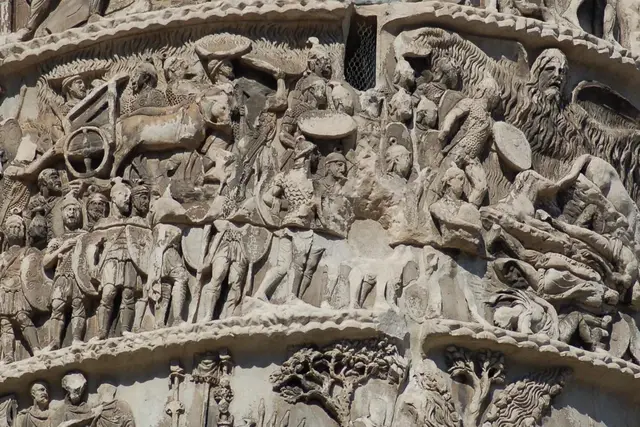Where the rain comes from had been known to the educated. The philosopher Aristotle, for example, had already accurately described in his meteorology in the 4th century before Christ that moisture on earth evaporates under the influence of the sun's rays, rises, condenses and falls back to earth. For the Roman architect Vitruvius, this physical process could be harnessed in Roman bath construction. "But despite scientific knowledge, rain itself was considered a phenomenon sent by the gods, such as by the weather god Zeus-Jupiter", says Burkhardt.
Extreme weather in Antiquity: Between belief in gods, science and prevention

In ancient times, individual scholars had repeatedly embraced the task of interpreting weather signs to be able to recognize upcoming rain and storms. Sun rays and cloud formation and also the behavior of animals were precisely linked to individual phenomena. In the 2nd to 3rd century A.D., the sophist Claudius Aelianus wrote in the 7th book of his animal stories in chapter 8, that if the ox roars and smells the earth, it must be raining, and if it eats a lot and more than usual, it indicates a severe weather. And if the owl cries out, one should expect a storm. These weather signs were also considered to be sent by the gods. The father of the gods was worshipped as Zeus Semeinos, the sign-giver.
By believing to know the originators, the ancient people could turn to them in case of inclemency. Zeus-Jupiter was one of the most invoked when one wanted natural forces corrected. In addition to prayers and sacrifices, people also resorted to magical rituals: In the Lycaion Mountains in Arcadia, the priests were able to create haze and clouds and thus rain above the spring of the nymph Hagno by means of sacrifices and oak branches, reported the Greek writer Pausanias.
The Romans called such rituals "aquaelicia". For example, they kept a stone, lapis manalis, outside the city walls in front of the Porta Capena in the sanctuary of Mars. The Roman lexicographer Festus tells us that when it was very dry, they would have pulled it into the city, and downpours were already falling. They would have taken the ritual from the Etruscans, and officials, the pontifices, were responsible for its performance. Burkhardt explains: "There were also processions of supplication for rain, where matrons, women citizens, barefoot and with loosened hair, went to the Temple of Jupiter on the Capitol along with officials without their status symbols. Such rituals represent a mental processing of the experience of disaster in the collective; it is easier to bear together and actively."

Thunderstorms may also have been decisive for wars: On the honorary column of Emperor Marcus Aurelius in Rome, a fierce bearded rain god symbolizes the salvaging rain that saved Roman troops from dying of thirst during their punitive expedition against the Quades in 173 A.D. Too much water was also a problem known to the Romans, because the Tiber would overflow its banks regularly and flood the city. According to Burkhardt, 30 flood disasters alone have been recorded over 800 years. The city was prone to flooding due to its topography, as it stretched between hills in the middle of a marshy plain. Poorer people in particular were affected when their shacks and sleeping quarters were washed away and the foundations of tenement houses were torn away.
"Greeks and Romans, however, did not rely solely on prayer, sacrifice, and magic. Especially since they were partly aware of anthropogenic causes, such as large-scale deforestation, deep mining and excessive dam building for river regulation", emphasizes the archaeologist. In ancient times, preventive measures with regard to storms and their consequences and relief actions after disasters triggered by them had already been known. In the 3rd and 2nd centuries B.C., for example, it was common for people to send letters of supplication to neighboring cities after major catastrophes; the Hellenistic rulers in particular had shown themselves to be benefactors and had granted aid for reconstruction. With the Romans, the emperors were in charge, not only concerning sympathy or financial contributions. Augustus had established the "vigilis", the fire protection force. To the present day, the Italian term for firefighters is "vigili del fuoco". Several emperors enacted building codes to ensure fire safety and stability. Junior Professor Burkhardt: "Emperor Trajan had drainage and diversion ditches dug in the 2nd century to counter the Tiber floods, as Pausanias writes in a letter to his friend Macrinus. And also in the 6th century, thanks to Prokop, it is recorded that Emperor Justinian, after terrible floods in Bithynia, had the riverbed dug open and mountain tops removed in order to build safe (elevated) roads." In the event of a disaster, the Roman state, in the person of the emperor, initiated relief measures such as repair grants, tax relief or special staff. Aid measures were not legally regulated in detail, but were probably part of what citizens could expect of the state and formed part of the topos of a good ruler.
"The topic 'Extreme weather in Antiquity' shows how the subjects of ancient studies must jointly evaluate the various sources in order to reconstruct ancient life situations: the written testimonies on rites, ideas, laws and achievements, the inscriptions for the worship of the gods and the repair measures, as well as archaeological findings for the reconstruction of what was actually implemented, for example, in flood protection measures", says Burkhardt.
![[Translate to Englisch:] Dürre](/fileadmin/_processed_/a/a/csm_AdobeStock_135100113_5c333a48a4.webp)